Page 20 of 546
02
2-7
DimEnsions
Itemsin. (mm)
Overall length 192.9 (4,900)
Overall width 73.2 (1,860)
Overall height 56.9 (1,445)
Front tread 205/65 R16
64.3 (1,633)
215/55 R17 63.9 (1,623)
235/45 R18 63.7 (1,618)
245/40 R19 63.3 (1,610)
Rear tread 205/65 R16
64.6 (1,640)
215/55 R17 64.2 (1,630)
235/45 R18 64.0 (1,625)
245/40 R19 63.6 (1,617)
Wheelbase 111.8 (2,840)
EnginE sPECifiCation
Item Smartstream G1.6 T-GDi Smartstream G2.5 GDi
Displacement cu. in. (cc) 97.08 (1,591)
152.37 (2,497)
Bore x Stroke in. (mm)3.03 x 3.06 (77 x 85.44) 3.47 x 4.00 (88.5 x 101.5)
Firing order 1-3-4-21-3-4-2
No. of cylinders 4, in-line4, in-line
Page 31 of 546
3-3
03
Front seats
(1)
F
orward and rearward
(2)
Sea
tback angle
(3)
Sea
t cushion height
(4)
Sea
t cushion angle
(5)
L
umbar support Rear seats
(6)
Armr
est
(7)
Sea
tback folding
SeatS
ODN8A030001
The actual layout of the vehicle may differ from the illustration.
„„Driver’s Side • Manual „„Passenger’s Side • Manual
• Power• Power
Page 34 of 546
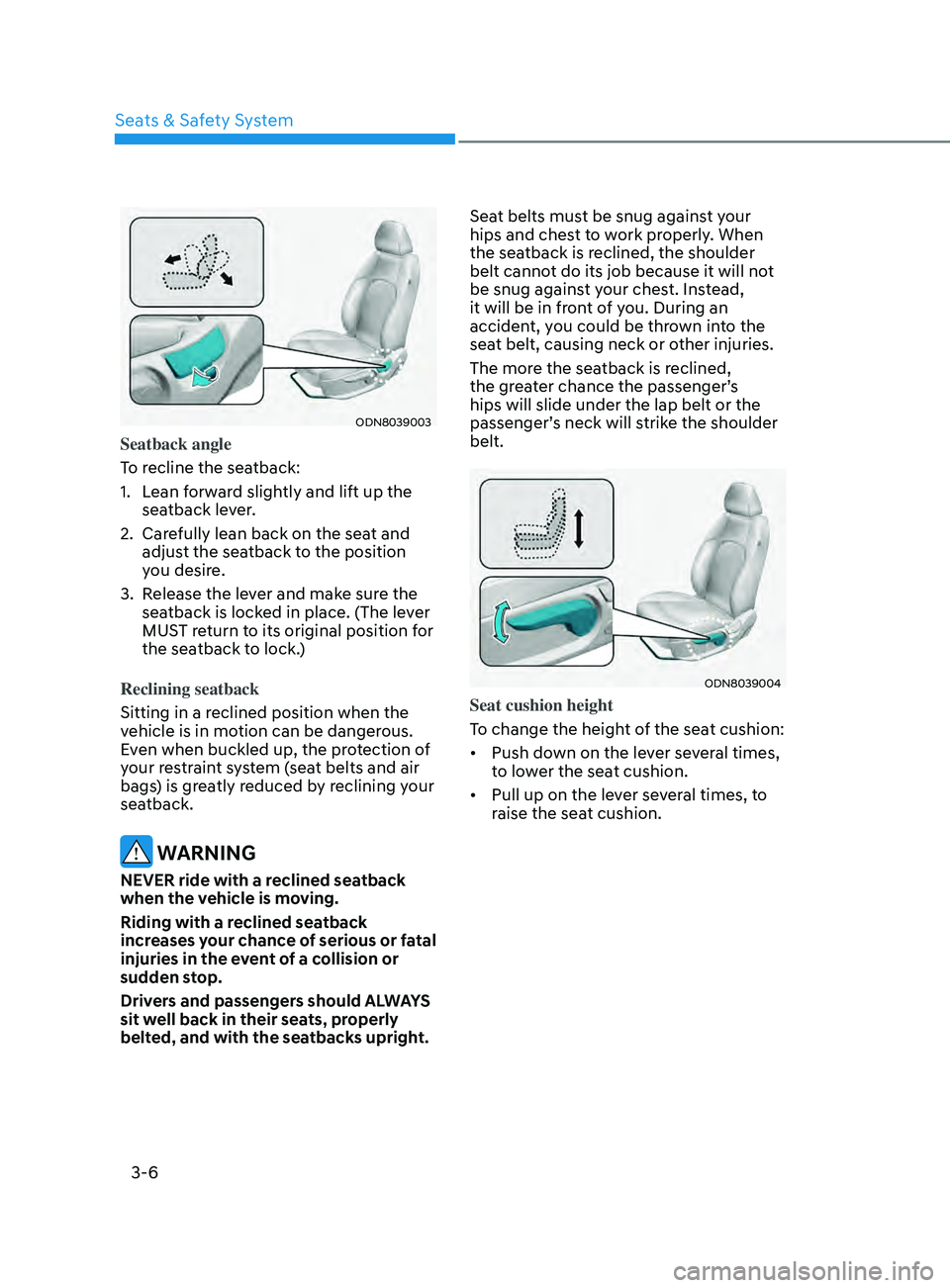
3-6
ODN8039003
Seatback angle
To recline the seatback:
1.
L
ean forward slightly and lift up the
seatback lever.
2.
Car
efully lean back on the seat and
adjust the seatback to the position
you desire.
3.
R
elease the lever and make sure the
seatback is locked in place. (The lever
MUST return to its original position for
the seatback to lock.)
Reclining seatback
Sitting in a reclined position when the
vehicle is in motion can be dangerous.
Even when buckled up, the protection of
your restraint system (seat belts and air
bags) is greatly reduced by reclining your
seatback.
WARNING
NEVER ride with a reclined seatback
when the vehicle is moving.
Riding with a reclined seatback
increases your chance of serious or fatal
injuries in the event of a collision or
sudden stop.
Drivers and passengers should ALWAYS
sit well back in their seats, properly
belted, and with the seatbacks upright. Seat belts must be snug against your
hips and chest to work properly. When
the seatback is reclined, the shoulder
belt cannot do its job because it will not
be snug against your chest. Instead,
it will be in front of you. During an
accident, you could be thrown into the
seat belt, causing neck or other injuries.
The more the seatback is reclined,
the greater chance the passenger’s
hips will slide under the lap belt or the
passenger’s neck will strike the shoulder
belt.
ODN8039004
Seat cushion height
To change the height of the seat cushion:
•
Push down on the lever several times,
to lower the seat cushion.
• Pull up on the lever several times, to
raise the seat cushion.
Seats & Safety System
Page 36 of 546
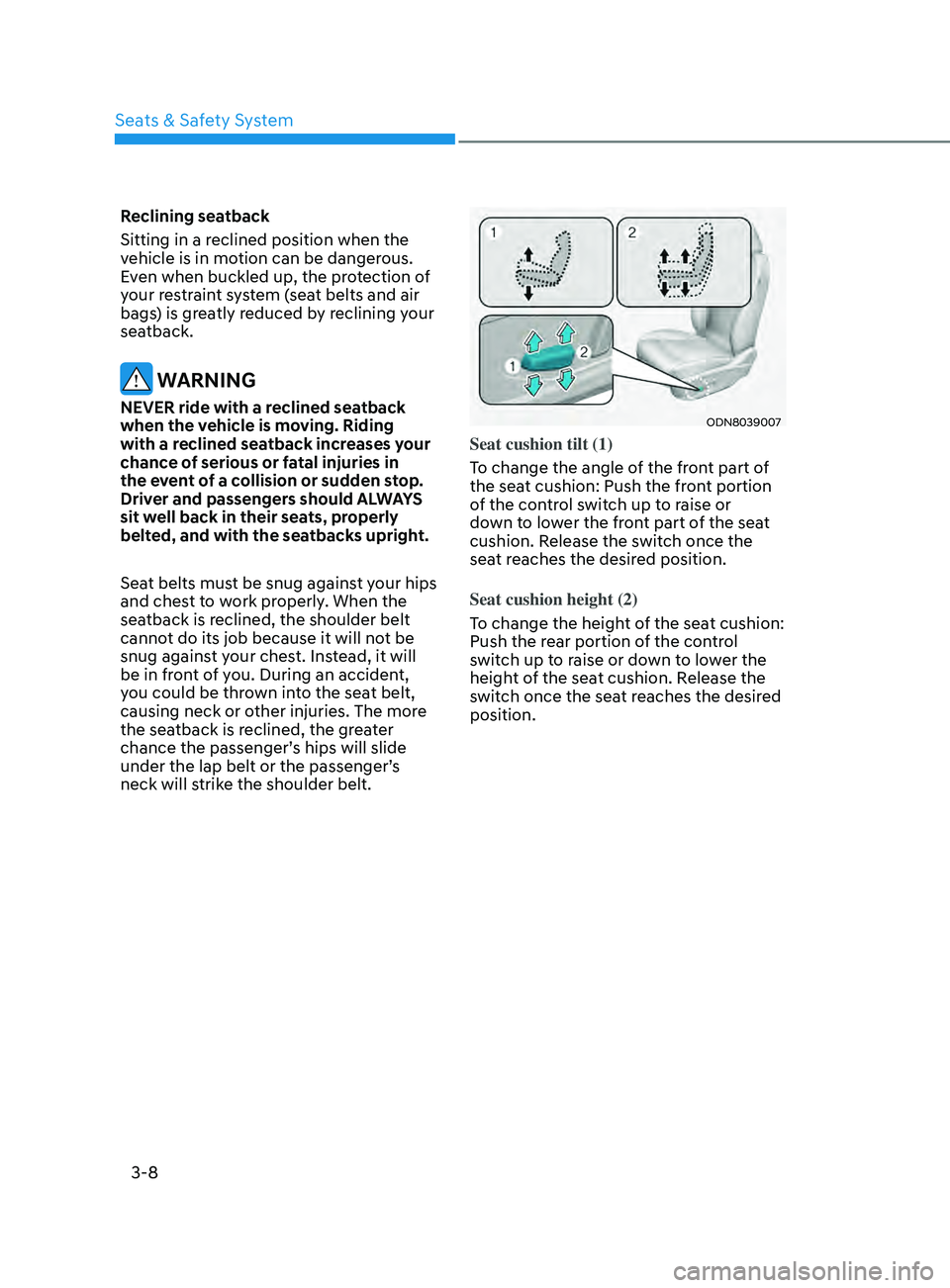
3-8
Reclining seatback
Sitting in a reclined position when the
vehicle is in motion can be dangerous.
Even when buckled up, the protection of
your restraint system (seat belts and air
bags) is greatly reduced by reclining your
seatback.
WARNING
NEVER ride with a reclined seatback
when the vehicle is moving. Riding
with a reclined seatback increases your
chance of serious or fatal injuries in
the event of a collision or sudden stop.
Driver and passengers should ALWAYS
sit well back in their seats, properly
belted, and with the seatbacks upright.
Seat belts must be snug against your hips
and chest to work properly. When the
seatback is reclined, the shoulder belt
cannot do its job because it will not be
snug against your chest. Instead, it will
be in front of you. During an accident,
you could be thrown into the seat belt,
causing neck or other injuries. The more
the seatback is reclined, the greater
chance the passenger’s hips will slide
under the lap belt or the passenger’s
neck will strike the shoulder belt.ODN8039007
Seat cushion tilt (1)
To change the angle of the front part of
the seat cushion: Push the front portion
of the control switch up to raise or
down to lower the front part of the seat
cushion. Release the switch once the
seat reaches the desired position.
Seat cushion height (2)
To change the height of the seat cushion:
Push the rear portion of the control
switch up to raise or down to lower the
height of the seat cushion. Release the
switch once the seat reaches the desired
position.
Seats & Safety System
Page 40 of 546
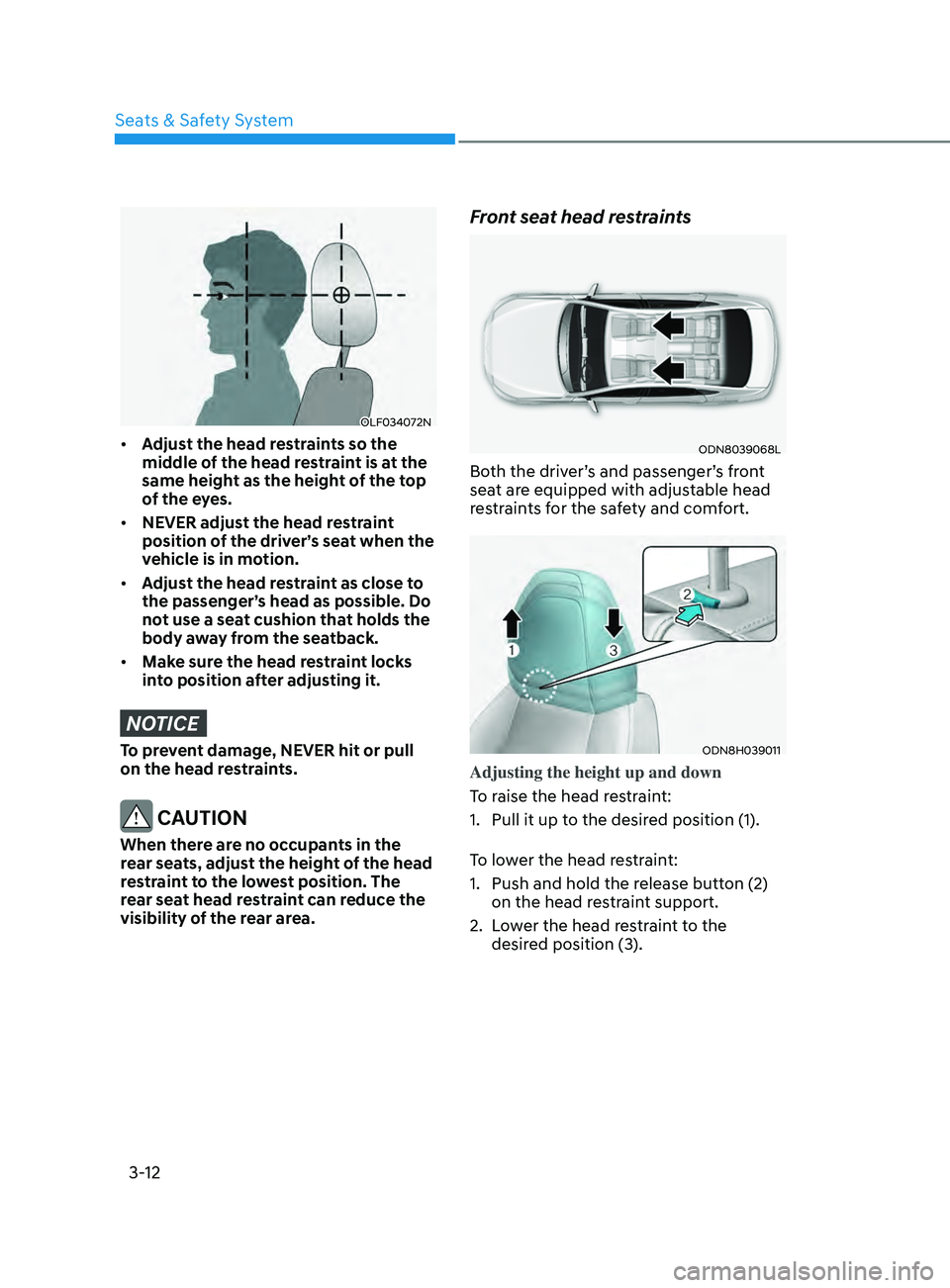
3-12
OLF034072N
• Adjust the head restraints so the
middle of the head restraint is at the
same height as the height of the top
of the eyes.
• NEVER adjust the head restraint
position of the driver’s seat when the
vehicle is in motion.
• Adjust the head restraint as close to
the passenger’s head as possible. Do
not use a seat cushion that holds the
body away from the seatback.
• Make sure the head restraint locks
into position after adjusting it.
NOTICE
To prevent damage, NEVER hit or pull
on the head restraints.
CAUTION
When there are no occupants in the
rear seats, adjust the height of the head
restraint to the lowest position. The
rear seat head restraint can reduce the
visibility of the rear area.
Front seat head restraints
ODN8039068L
Both the driver’s and passenger’s front
seat are equipped with adjustable head
restraints for the safety and comfort.
ODN8H039011
Adjusting the height up and down
To raise the head restraint:
1.
Pull it up t
o the desired position (1).
To lower the head restraint:
1.
Push and hold the r
elease button (2)
on the head restraint support.
2.
L
ower the head restraint to the
desired position (3).
Seats & Safety System
Page 42 of 546
3-14
„„Type A
ODN8039014
„„Type B
ODN8039015
To reinstall the head restraint:
1.
Put the head r
estraint poles (2) into
the holes while pressing the release
button (1).
2.
A
djust the head restraint to the
appropriate height.
3.
A
djust the seatback (4) forward using
the seatback angle lever (3).
Rear seat head restraints
ODN8039069L
The rear seats are equipped with head
restraints in all the seating positions for
the passenger’s safety and comfort.
ODN8H039017
Adjusting the height up and down
To raise the head restraint:
1.
Pull it up t
o the desired position (1).
To lower the head restraint:
1.
Push and hold the r
elease button (2)
on the head restraint support.
2.
L
ower the head restraint to the
desired position (3).
Seats & Safety System
Page 49 of 546
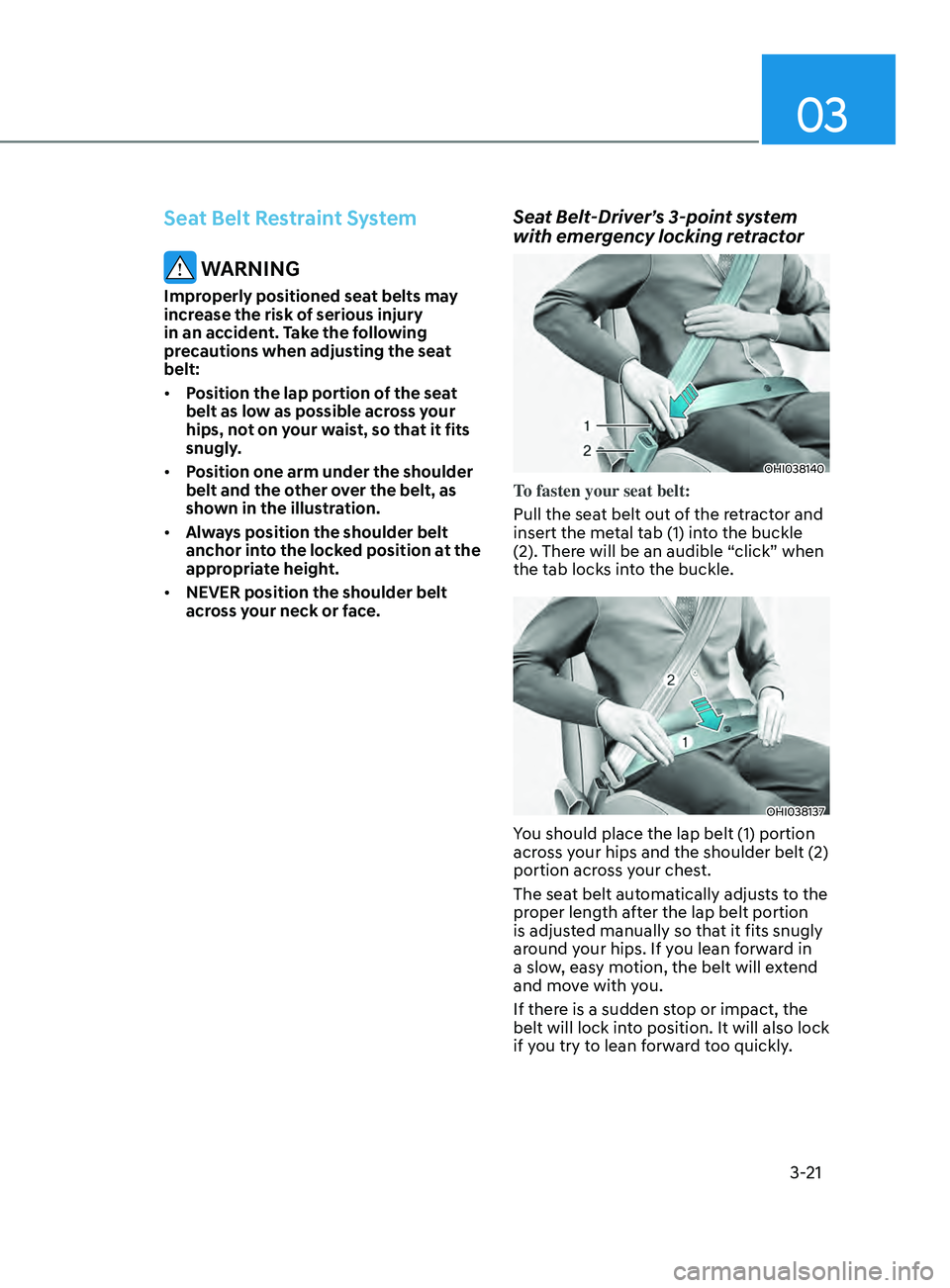
03
3-21
Seat Belt Restraint System
WARNING
Improperly positioned seat belts may
increase the risk of serious injury
in an accident. Take the following
precautions when adjusting the seat
belt:
• Position the lap portion of the seat
belt as low as possible across your
hips, not on your waist, so that it fits
snugly.
• Position one arm under the shoulder
belt and the other over the belt, as
shown in the illustration.
• Always position the shoulder belt
anchor into the locked position at the
appropriate height.
• NEVER position the shoulder belt
across your neck or face.
Seat Belt-Driver’s 3-point system
with emergency locking retractor
OHI038140
To fasten your seat belt:
Pull the seat belt out of the retractor and
insert the metal tab (1) into the buckle
(2). There will be an audible “click” when
the tab locks into the buckle.
OHI038137
You should place the lap belt (1) portion
across your hips and the shoulder belt (2)
portion across your chest.
The seat belt automatically adjusts to the
proper length after the lap belt portion
is adjusted manually so that it fits snugly
around your hips. If you lean forward in
a slow, easy motion, the belt will extend
and move with you.
If there is a sudden stop or impact, the
belt will lock into position. It will also lock
if you try to lean forward too quickly.
Page 50 of 546
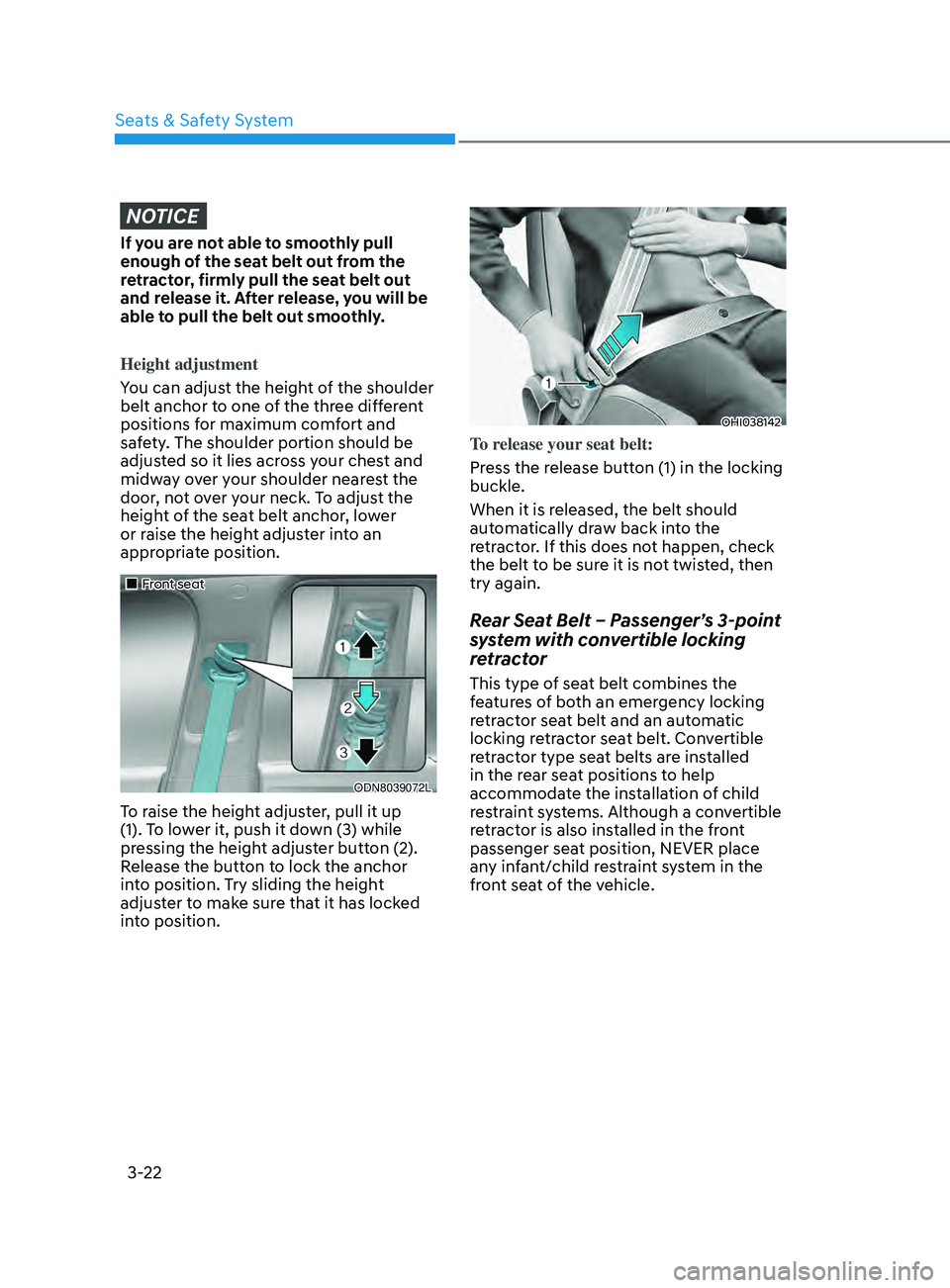
3-22
NOTICE
If you are not able to smoothly pull
enough of the seat belt out from the
retractor, firmly pull the seat belt out
and release it. After release, you will be
able to pull the belt out smoothly.
Height adjustment
You can adjust the height of the shoulder
belt anchor to one of the three different
positions for maximum comfort and
safety. The shoulder portion should be
adjusted so it lies across your chest and
midway over your shoulder nearest the
door, not over your neck. To adjust the
height of the seat belt anchor, lower
or raise the height adjuster into an
appropriate position.
„„Front seat
ODN8039072L
To raise the height adjuster, pull it up
(1). To lower it, push it down (3) while
pressing the height adjuster button (2).
Release the button to lock the anchor
into position. Try sliding the height
adjuster to make sure that it has locked
into position.
OHI038142
To release your seat belt:
Press the release button (1) in the locking
buckle.
When it is released, the belt should
automatically draw back into the
retractor. If this does not happen, check
the belt to be sure it is not twisted, then
try again.
Rear Seat Belt – Passenger’s 3-point
system with convertible locking
retractor
This type of seat belt combines the
features of both an emergency locking
retractor seat belt and an automatic
locking retractor seat belt. Convertible
retractor type seat belts are installed
in the rear seat positions to help
accommodate the installation of child
restraint systems. Although a convertible
retractor is also installed in the front
passenger seat position, NEVER place
any infant/child restraint system in the
front seat of the vehicle.
Seats & Safety System